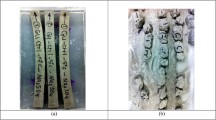Abstract
SULPHATE attack is a significant problem which locally affects concrete and other construction materials in the United Kingdom and overseas. The mechanisms of sulphate attack are fairly well understood, but in some instances it has proved difficult to establish the origin of the sulphate. Possible sulphate sources include soils and ground water, sea water, atmospheric pollution, contaminated ground-fill and highway de-icing salts. Here we show that stable-sulphur-isotope analysis can help to identify the causes of sulphate attack. We carried out this investigation primarily to determine whether sulphate impurities in rock salt used for winter maintenance of the roads could be responsible for higher than expected sulphate levels that have been observed in parts of some road bridges. Our sulphur isotope results indicate that this is not the case, and indicate that atmospheric sulphate sources are more important.
Similar content being viewed by others
References
Figg, J. Chem. Ind. 17 October, 770–775 (1983).
Benstead, J. World Cement Technol. May, 178–184 (1981).
Mehta, P. K. Cement Concrete Res. 13, 401–406 (1983).
Crammond, N. J. Cement Concrete Res. 15, 431–441 (1985).
BRE Digest 250 Concrete in Sulphate-bearing Soils and Groundwaters. (Building Research Establishment, Garston, 1981).
Cooke, R. U. & Smalley, I. J. Nature 220, 1226–1227 (1968).
Sperling, C. H. B. & Cooke, R. U. Earth Surface Processes and Landforms 10, 541–555 (1985).
Goudie, A. S. Sch. Geogr. Res. Pap. 33, (University of Oxford, 1986).
Lossing, F. A. Highway Res. Board Rec. 113, 88–103 (1966).
Mourn, J. & Rosenquist, I. T. J. Am. Concrete Inst. September, 257–264 (1959).
Cheetham, D. W. & Banfill, P. F. G. Construction Pap. 1, 7–16 (1980).
St John, D. A. Cement Concrete Res. 12, 633–639 (1982).
Pye, K. & Hudson, A. J. New Civil Engnr 10 July, 16–17 (1986).
Mineral Resources Consultative Committee Salt. (HMSO, London, 1971).
Holt, B. D. & Engelkemeir, A. G. Analyt. Chem. 42, 1451–53 (1970).
Faure, H. Principles of Isotope Geochemistry 2nd edn, 523–552 (Wiley, New York, 1986).
Author information
Authors and Affiliations
Rights and permissions
About this article
Cite this article
Pye, K., Schiavon, N. Cause of sulphate attack on concrete, render and stone indicated by sulphur isotope ratios. Nature 342, 663–664 (1989). https://doi.org/10.1038/342663a0
Received:
Accepted:
Issue Date:
DOI: https://doi.org/10.1038/342663a0
- Springer Nature Limited
This article is cited by
-
Isotopes in cultural heritage: present and future possibilities
Heritage Science (2018)
-
Petrophysical properties, composition and deterioration of the Calatorao biogenic stone: case of the sculptures masonry of the Valley of the Fallen (Madrid, Spain)
Environmental Earth Sciences (2013)
-
Decay effects of pollutants on stony materials in the built environment
Environmental Chemistry Letters (2012)
-
Natural and anthropogenic sources of total suspended particulate and their contribution to the formation of black crusts on building stone materials of Catania (Sicily)
Environmental Earth Sciences (2012)
-
Source identification of sulphate forming salts on sandstones from monuments in Salamanca, Spain—a stable isotope approach
Environmental Science and Pollution Research (2010)





